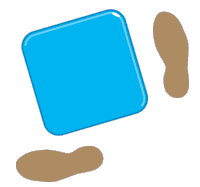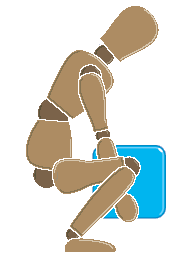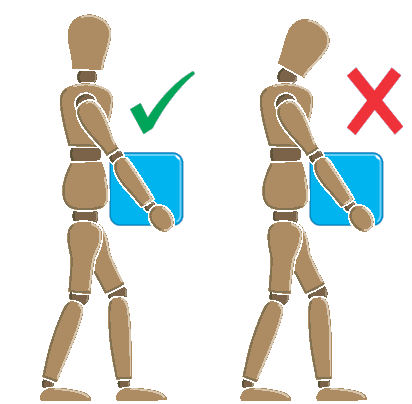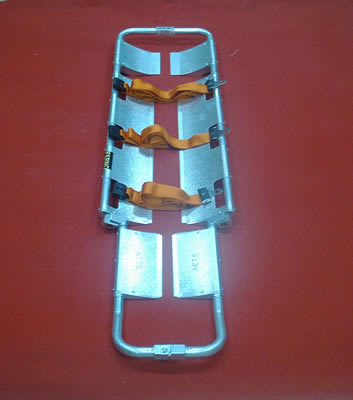Lifting and Handling
Manual handling injuries can occur wherever people are at work - on farms and building sites, in factories, offices, warehouses, hospitals, banks, laboratories, and while making deliveries. Heavy manual labour, awkward postures, manual materials handling, and previous or existing injury are all risk factors implicated in the development of MSD's (musculoskeletal disorders).
Risk Assessment
There are four universal principles which when applied to every manual handling situation can reduce the risk of injury.
L I T E
Load
Individual
Task
Environment
We'll look at these headings one at a time
Load:
Object
- How much does it weigh?
- Is it a standard shape?
- Is it a predictable load?
- Is it bulky?
- Is it difficult to grasp?
- Is it sharp?
Patient
Physical state- Are they weak?
- Can they balance?
- Can they weight bear?
- Are they debilitated in any way?
- Are they in pain?
- How flexible are they?
- Have they any sensory loss?
- Are they conscious /unconscious?
- Do they have any equipment attached?
- How old are they?
- Who much do they weigh?
- Can they understand what is happening?
- Are they unpredictable?
- Are they anxious?
- Are they afraid?
- Will they resist?
- Are they cooperative?
- Are they depressed?
- Are there any language barriers?
- Are there any communication barriers?
- Are there any ethical/cultural considerations?
- Are there any gender considerations?
- Is there any family involvement?
Individual:
- Have you been had Manual Handling training?
- Has the person you’re working with had Manual Handling training?
- Have your Manual Handling techniques been assessed?
- Have you performed this procedure with this patient before?
- Have you had an injury?
- Do you think you can manage the load safely?
- Are you pregnant or have your recently had a baby?
- Are you on an early, late, night or long day?
- How many shifts have you worked recently?
- Have you considered your general fitness?
- Are you wearing appropriate clothing and foot wear?
Task
- How much can the patient do?
- Does it need to be done?
- How often do you need to do it?
- Does it involve static postures such as holding limbs?
- Does it involve pushing, pulling, reaching, twisting, or stooping?
- Does it involve awkward postures?
- Are there sufficient numbers of staff?
- Are there any restrictions of movement?
- Does it involve manually carrying over a distance?
- Is there a risk of sudden movement?
- Have you considered the height of the manoeuvre?
- Does it involve holding the load at a distance from the body?
Environment
- Is there enough space?
- Is there adequate lighting?
- Are the floor surfaces slippery?
- Are the floor surfaces uneven?
- Is the equipment being used adequate and in good repair?
- Is the equipment adjustable?
Always consider all aspects of the LITE procedure before attempting any sort of lift. Whether it's a small box off the floor or a 15 stone patient. Remember it's your back, if that becomes damaged it's also the end of your career.
Good Manual Handling Technique
In the following section a basic lifting operation is taken as an example.
● Think before lifting/handling. Plan the lift. Can handling aids be used? Where is the load going to be placed? Will help be needed with the load? Remove obstructions such as discarded wrapping materials. For a long lift, consider resting the load midway on a table or bench to change grip.
● Keep the load close to the waist. Keep the load close to the body for as long as possible while lifting. Keep the heaviest side of the load next to the body. If a close approach to the load is not possible, try to slide it towards the body before attempting to lift it.
● Adopt a stable position. The feet should be apart with one leg slightly forward to maintain balance (alongside the load, if it is on the ground). The worker should be prepared to move their feet during the lift to maintain their stability. Avoid tight clothing or unsuitable footwear, which may make this difficult.
● Get a good hold. Where possible the load should be hugged as close as possible to the body. This may be better than gripping it tightly with hands only.
● Start in a good posture. At the start of the lift, slight bending of the back, hips and knees is preferable to fully flexing the back (stooping) or fully flexing the hips and knees (squatting).
Getting to grips with manual handling
● Don’t flex the back any further while lifting. This can happen if the legs begin to straighten before starting to raise the load.
● Avoid twisting the back or leaning sideways, especially while the back is bent. Shoulders should be kept level and facing in the same direction as the hips. Turning by moving the feet is better than twisting and lifting at the same time.
● Keep the head up when handling. Look ahead, not down at the load, once it has been held securely.
● Move smoothly. The load should not be jerked or snatched as this can make it harder to keep control and can increase the risk of injury.
● Don’t lift or handle more than can be easily managed. There is a difference between what people can lift and what they can safely lift. If in doubt, seek advice or get help.
● Put down, then adjust. If precise positioning of the load is necessary, put it down first, then slide it into the desired position.
This information was taken from 'Getting to grips with manual handling'. Published by HSE
Equipment
Carrying Chair - This piece of equipment is probably one of, if not, the most used piece of equipment on an ambulance.
Description - Portable folding chair with wheels
Function - For carrying and wheeling patients in varying circumstances. e.g. Up or down stairs, in a lift, along narrow pathways. Usually only used to convey conscious patients but can be used for unconscious if the airway can be maintained. The use of a cervical collar will accomplish this.
Orthopaedic Stretcher (Scoop) - A metallic stretcher that can be split into two halves for easy loading of casualty onto the stretcher.

Function - For lifting a casualty with fractures or spinal injuries
Service Checks: As with all equipment it should be regularly checked to make sure it is operational and does not have any faults. Check that all aspects, especially the adjusters, coupling latch and locking devices. Inspect straps for wear, loose stitching and that locking catches are working correctly. If any part of the equipment is faulty you should remove from the vehicle and report to your equipment department and fill in relevant paperwork as per your service requirements.
Loading the patient:
-
Always tell the patient your intentions
-
Place equipment next to patient and adjust the length
-
Place 1 side at a time under the patient and clip the ends together (head end first). Be careful when closing the 2 halves as the stretcher could pinch the lower points of the body, i.e. Buttocks, shoulders and head.